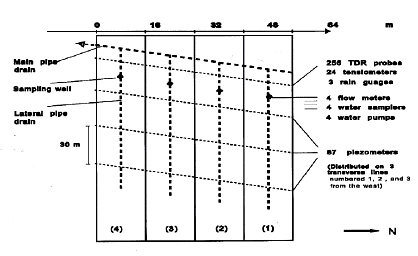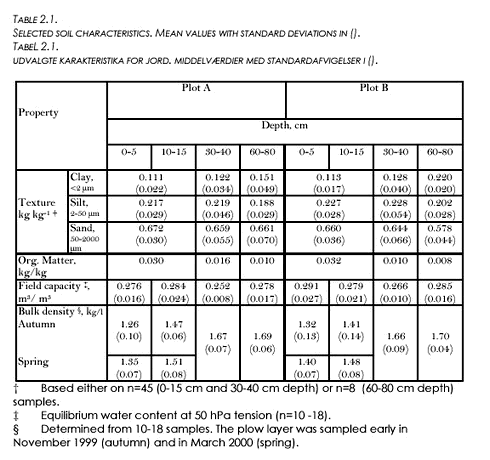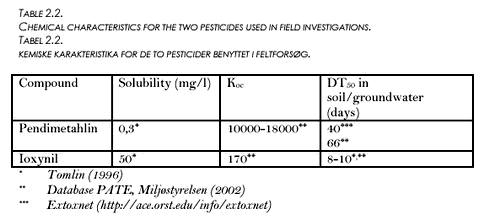Facilitated transport of pesticides
2 Field experiments2.1 Description of experimental setup2.1.1 Physical layout 2.1.2 Soil 2.1.3 Tillage treatment 2.1.4 Chemical Application 2.1.5 Sampling of drain water and soil 2.1.6 Analyses The aim of the present field investigations was to obtain information on the dynamics and the extent of Pendimethalin and Ioxynil movement into subsurface drains, and the conditions and transport mechanisms governing pesticide and soil particle losses with drainage water. The field experiments were carried out in corporation with The Royal Veterinary and Agricultural University (KVL) at their test facilities at Rørrendegaard near Høje Tåstrup. Experiments were carried in two winter seasons; 1999-2000 and 2000-2001. 2.1 Description of experimental setup2.1.1 Physical layoutThe experimental site consisted of four plots (each 16 by 100 m2) located adjacent to each other. The four plots were established in such a way that they were drained by lateral tile drain pipes, each 100 m long and each located 1,1 m below ground surface (installed in 1965). A sampling well was established downstream on each drain, allowing for drain flow measurements (tipping bucket system, resolution app. 10 l) and water sampling. The perforated drain line and the sampling well were connected by a 3 m long tight pipe, eliminating the risk of direct contamination along the side walls of the well. The maximum level difference within the field was approximately 0.7 m. Liquid soil water content was determined in an area downstream to the sampling wells using the TDR technique. 32 TDR probes (30 cm long) were installed horisontally with minimal soil disturbance along a transect at 8 and 16 cm depth, 8 probes at each depth in each plot. Precipitation was measured using one centrally located rain gauge (resolution 0,1 mm) and two control gauges. The physical layout is presented in Figure 2.1;the plots A and B on which the experiments have been conducted are plots (3) and (4), respectively.
FIGURE 2.1. FIGUR 2.1.
2.1.2 SoilThe soil was developed on moraine deposits from the Weichselian Glaciation, and was classified as an Agrudalf. It bore the impressions of a long duration of cultivation with an agric horizon located directly below the plow layer at 25-35 cm depth. Aggregates with clay skin had developed in the Bt horizon. The depth to the C horizon (containing calcite) was 110 cm on average. The Bt horizon exhibited a well developed structure with angular to columnar aggregates. The upper horizons were characterised by weak, subangular aggregates, tending towards a platy structure in the agric horizon. Biopores were dominated by root and vertically oriented earthworm channels transecting the aggregates. The root channels were generally smaller than 2 mm diameter, whereas the worm channels were between 3 and 8 mm diameter, extending to 20 mm in the worm cavities. Rough estimates on the number of earthworm channels were made on large lumps of soil taken from the profile. Common numbers found in the Bt horizon at 50 cm depth were 2-6 channels per 100 cm2 horizontal cross section. There were coatings of clay and humus-rich particles on the pore walls. The number of channels decreased rapidly from about 90 cm depth, though some channels penetrated below 130 cm depth. The entire subsoil below 30 cm depth was relatively compact with mean bulk densities between 1,66 and 1,70 kg/l. Selected soil characteristics are given in Table 2.1
2.1.3 Tillage treatmentTillage treatments were both years: Plot A : ploughing (25-28 cm depth), light subsurface compaction, one intense harrowing with a PTO-driven rotary harrow (5 cm depth), drilling. Plot B : ploughing (25-28 cm depth), one harrowing with a spring-tooth harrow (4-6 cm depth), drilling. The two treatments represent conventional soil preparation methods for wheat used in Denmark. Wheat was used as test crop both seasons. 2.1.4 Chemical ApplicationPendimethalin (N-(1-ethylpropyl)-3,4 dimethyl-2,6 dinitrobenzenamine) at a dose of 2,00 kg/ha was applied in Stomp SC on November 16 1999. Ioxynil at 0.200 kg ha-1 was applied together with Pendimethalin at 2.00 kg ha-1 on November 10 in 2000. Both applications were using a pesticide sprayer. The two herbicides were applied in the following commercial formulations: Pendimethalin 400 g l-1 (’Stomp’ SC, BASF) and Ioxynil 200 g l-1 (’Oxitril’ CM, Aventis). The applied doses were maximum doses according to recommendations for practical agriculture. All applications were given uniformly to the entire plot areas, except on a 5 m belt upstream from the sampling well. No Pendimethalin had been applied at the site during the 3 years period up to November 1999. Pendimethalin and Ioxynil are widely used herbicides in Denmark
Pendimethalin adsorbs strongly to topsoils and has reported soil-water partition coefficients (Kd values) ranging from 99.8 (0.59 % organic carbon) to 1638 (16.9 % organic carbon) (Pedersen et al., 1995; Zheng and Cooper, 1996). Increasing soil organic matter and clay content is associated with increased soil binding capacity (Extoxnet, 2002). Ioxynil adsorbs weakly (Kjær et al., 2001) and is considered to be mobile in soil (Aventis, 2000). However, it may have a fairly low persistency with DT50 values for topsoil of about 10 days (Extoxnet, 2002) or less (Kjær et al, 2001). Based on the strong affinity for the soil, Pendimethalin was not expected to be transported in significant amounts in the traditional perception of dissolved species transport. Thus, any significant leaching of Pendimethalin was expected to be related to particle-facilitated transport. The much more soluble Ioxynil was expected to be transported dissolved in the water phase, given that the low persistency to degradation would allow for any detectable leaching . The two compounds were applied simultaneously in the second season of sampling to compare the leaching dynamics of the two different pesticides. 2.1.5 Sampling of drain water and soilDrain water sampling was performed on a flow-related basis. The maximum resolution was one separate sample per 0.025 mm drain flow with subsampling for every 0.0063 mm. The minimum resolution was 1 separate sample per 0.2 mm drain flow with subsampling for every 0.05 mm. Both samplers‡‡ were equipped with teflon tubes and a roundabout with 24 half litre glass vessels. A total of 1913 separate samples were taken in the two plots. Turbidity (expressed in Nephelometric Turbidity Units, NTU) was measured† during the two seasons, plus the preceeding season 1998-1999, in all water samples with visual indications of suspended matter (421 samples in total), and in 24 randomly selected samples without such visible indications. The content of suspended matter was determined by centrifugation in 77 drain water samples with visible indications of suspended matter. Analyses for pesticides were performed on 50 water samples during the 1999/00 season (Pendimethalin) and on 38 water samples during the 2000/01 season (Pendimethalin and Ioxynil). When selecting samples for pesticide analyses, focus was given to the first drain flow events after application. Drain water flow was measured continuously using a tipping bucket system (resolution: about 0.0063 mm). Precipitation was registered at the site every 5 minutes (resolution: 0.1 mm). Liquid soil water content at 8 and 16 cm depth was determined from measured dielectric constant using the TDR-technique (Topp et al., 1980; Hayhoe and Bailey, 1985). Measurements were performed every two hours during the first two seasons. Thirty-two TDR-probes (30 cm long) were installed horizontally along a transect downstream to the sampling wells; 8 probes at each depth in each plot (see Figure 2.1). Soil cores for Pendimethalin analyses were sampled before and right after Pendimethalin application on November 16th 1999 (0-4 cm depth), and on February 24th 2000 (0-35 cm depth). Sixteen randomly located soil cores were taken each date in each plot. The sixteen soil cores were pooled to obtain one composite sample. The soil samples were immediately frozen at –20oC and kept frozen until analysis. 2.1.6 AnalysesAnalyses for Pendimethalin for the season 1999-2000 were performed at The Department of Environmental Assessment at The Swedish University of Agricultural Sciences, Uppsala, Sweden according to procedures described by Andersson (1999). Analyses for Pendimethalin and Ioxynil for the season 2000-2001 were performed at DHI. Drain water samples were separated into an aqueous and a solid phase using a filtration technique (0.7 µm glass micro fibre filter). Pendimethalin and Ioxynil were extracted from solid phases by Soxtec extraction using either a mixture (1:1 v/v) of dichloromethane and acetone (1999/00 season) or acetone (2000/01 season) as solvent. A polystyrene divinylbenzene polymer was used as adsorbent in the aqueous phase. During the 1999/00 season, samples were analysed for Pendimethalin using a Hewlett Packard model 5890A gas chromatograph (detection limit: 0.04 µg l-1). During the 2000/01 season, samples were analysed for Pendimethalin (detection limit: 0.01 µg l-1) and Ioxynil (detection limit: 0.03 µg l-1) using HPLC-technique. Samples were kept at 5o C from the time of sampling until filtration and analyses were performed. This period extended from a few days to weeks. The content of suspended matter in drain water was determined by centrifugation (30 min at 5000 rpm or 4100 g‘s) and drying of the precipitate (110o C).
‡‡ Model Epic 1011 from Bühler Montec ( http://www.BuhlerMontec.co.uk) |


